An Actual Fantastic Discussion on Race and The Vampire Diaries...
If you know me at all, you'll know that this is a subject that rests very close to my heart and weighs upon it every single time there is an episode of this show. This article is really great and I have so many complicated feelings on the matter and I thought I'd share it here if anyone's interested. There are some points I find problematic and some that I downright don't agree with. But....
Table For Two: Kendra And Jordan Break Down The Vampire Diaries
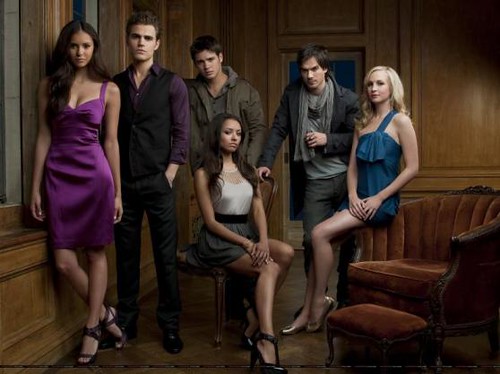
By Guest Contributors Kendra James and Jordan St. John
Never seen The Vampire Diaries? Here’s a synopsis (with spoilers). There’s Elena (Nina Dobrev) the “average” popular orphan girl in Mystic Falls, VA. Caroline ( Candice Accola) her blond haired, blue eyed cheerleading frenemy and Bonnie (Kat Graham) her requisite black best friend and side kick. Elena also happens to be the spitting image of a vampire, Katherine, who loved Damon and Stefan Salvatore (brothers played by Ian Somerhalder and Paul Wesley) in the same town during the Civil War. Come 2009 the brothers return to Mystic Falls, only to both fall in love with Elena - a plot that makes just as much sense now as it did when TVD actually debuted as a book series in the early 1990s. But hey, let’s go with it.
Elena fell in love with Stefan during the show’s first season, but now things are heating up between her and Damon. It’s a crazy ride of a show but one of the most fascinating things is its strange dance with race. Set in the current south but with self-professed ties to the Civil War era and more recently precolonial America, as Dr. Sayantani DasGupta wrote for Racialicious last year, the show sometimes doesn’t know what to do with pesky issues like racism and slavery. As the show’s third season resumes this week, let’s look back at the racial implications and issues of the residents of Mystic Falls since the Season 2 finale.
Why We Love It
Kendra: In a media world saturated with vampires, werewolves, witches, and other secret societies, the show, now a mainstay on The CW network, has gone on to easily become my favorite hub of angsty supernatural teenage adventures. The cheesy premise disguises a surprisingly smart show that, once it found its’ stride during the first season, keeps me hooked with its nearly weekly cliffhangers and lead female characters who usually go out of their ways to be the anti-Bella Swan.
Jordan: I second that. TVD moves faster than any other show on television. Some subplots most series would spend half a season developing, unfold in the course of one episode (such as last season’s finale, where Elena’s Aunt/Guardian, father and brother all died in about a 15-minute span). And in a teen pop-culture landscape that is sometimes obsessed with female frailty and chastity, Elena isn’t even asked to apologize for simultaneously dating two brothers, and neither is Katherine. Yes, the women sometimes require saving but with a powerful female witch and vampire in the mix, they do the saving as well.
Why It’s Still A CW Show
Kendra: Like we said earlier, the show anchors itself in the American past and deals with it in some curious - and problematic - ways, often featuring flashbacks to the Civil War and present-day town events influenced by it. I wish I could understand why everyone’s decided vampires are all Southern these days, but that’s where we are, and TVD will always, to me, be a younger and better version of True Blood. But it’s not perfect. The show’s writers could have easily acknowledged the racial and social issues that come with placing yourself within the context of war and tackled the issues head on, instead of dancing around as True Blood tends to do.
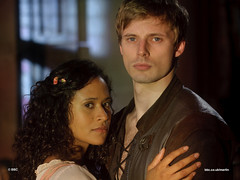
Jordan: Alas, TVD goes a couple steps forward - adding Bonnie as a main character (and a whole line of black witches) and including a Civil War era Asian vampire, Pearl, and then stumbles back by shying away from addressing the legacy of slavery in the American south and falling into stereotypes. I usually applaud color blind casting in fantasy or supernatural (the only reason I watch Merlin is because they made the future Queen Guinevere multiracial. If you are in a fictional place where dragon’s talk, I applaud it when producers do not carryover our preconceptions of race) but that only works when the setting is another world - not the current American south.
The Mystic Falls Civil War Fetish
Kendra: Moving the Salvatore brothers’ history into the Civil War had to be an extremely conscious decision on the part of series creator and producer Kevin Williamson and his team, because none of that is actually a part of author L.J. Smith’s original books, in which the Salvatores were both supposedly turned during the Italian Renaissance.
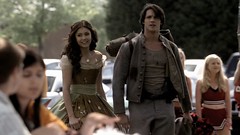
Now, I can understand why he did it: True Blood was already popular by the time TVD premiered, and the public showed it loved them some southern vampires. And a war on American soil is something the main TVD audience (Americans in the 18-35 demographic) is going to know more about and possibly find more relatable than something going on in Italy. But it never fails to amaze me how a well documented period in American history can be glossed over so thoroughly, and I always wonder why it’s a period chosen so frequently as a media plot device when no writing staff is actually brave enough to use it for what it really was.
A friend of mine jokingly said to me that the show must take place in some sort of alternate America where the War somehow didn’t end as badly, no one in the south is resentful about it, and it wasn’t a complete disadvantage to be a person of color in the south during and before the 1860s. Mystic Falls is presented as an idyllic town where attractive men dress in Rebel Greys and the women dress in Southern Belle gowns for various town occasions, where Black servants during the war were referred to as ‘handmaidens’, and where a fully multicultural town (including Asians!) was perfectly normal for Virginia in 1865.
So why obsess over the conflict if you’re not going to acknowledge it for what it was?
Jordan: TVD seems to be pulling a Bagger Vance - and if you ever want to see a movie with a black main character in the south completely gloss over race, it is a truly striking example; I literally wrote a paper on it. In most of the flashbacks, we have Bonnie’s ancestor, Emily Bennett serving Katherine: She provides her with a ring to walk around in the daylight and also provides daywalking ring for the newly turned Salvatore brothers. While I understand the need for Emily to assist with a number of plot points, I am disappointed that they never take the time to look at Emily as a dynamic character. What is her backstory? Why is a black witch who has the power to control humans and vampires, staying with an evil, murderous vampire in the Civil War era south? Why is she helping her? Emily does always put her own family first whenever her or any of her descendants are threatened, but the lack of time spent looking into her motivations is a glaring omission.
All I need is a nod to slavery - an acknowledgement that there is another facet to the plantation era American south that was not about bonnets, balls and “servants” who all happened to share a skin tone. True Blood has its own faults, but the scene when Tara asked if Bill ever had slaves will always have a place in my heart.
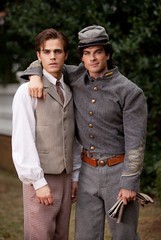
TVD has rare instances of this kind of honesty that I appreciate. I love that earlier in the series, when a southern matriarch is asked by her son about a dungeon on their old plantation property (which actually was used to chain up werewolves) she assumed it had been used to hold slaves and told him in terse terms that it wasn’t something the family liked to discuss before quickly moving on to other things. There are ways to incorporate the darker parts of southern history into the plot but they take a little effort and creativity. All too often, the show shirks from the challenge and opts to gloss over the realities of the Civil Was era. For example, the Salvatores were people of stature in a southern, plantation town, meaning they would have certainly owned slaves. I would love for at least one person to acknowledge that - preferably Bonnie.
Kendra: While watching the mid-season premiere, I was asked, “Why is Emily Bennett still holding that grudge against the Salvatores? It’s been over a century!” a question that pinpoints the problem with dodging the town’s history of slavery. To me, even peeling away the vampiric elements of the story, I have absolutely no problem imagining why Emily, a powerful Black woman would continue to hold a grudge against two rich (potentially slave holding), southern white men from she’d known in 1865. I wish there was someone in that writer’s room willing to take a non-white perspective into account. Not only do I find it problematic that my own view isn’t acknowledged, it’s concerning to me that this idyllic view of the Confederate South is presented without question or discourse to a large swath of young, white CW-watching America.
Romanticizing and whitewashing the African-American experience isn’t a new occurrence (see: Gone With The Wind or Douglas Sirk’s remake of Imitation of Life, to name a few), and it’s troubling to see the trend surface again in 2012. To be fair, this show isn’t the only pop culture phenom guilty of peddling a “safer” version of Southern America and Confederate history to the American youth. It’s simply the most recent. Acts like Taylor Swift and Lady Antebellum, and programs like its’ CW compatriot Hart of Dixie all conjure up images of the “Safe South” in their descriptions (lyrically) and depictions (visually) of the region.
Now, I’m not recommending that today’s youth get their history lessons from the CW and Taylor Swift, but the fact remains that even I, as a young Black kid, was drawn into the romanticism of the Old South. A visceral book description (visceral for an 8-10 year old, at least) of my American Girl Doll, Addy, being forced to eat grubs off a tobacco leaf by her overseer fixed that up right quick, and I suppose I worry that others -white and Black- aren’t going to receive the same historical wake up call if Lady Antebellum, Taylor Swift, and TVD are the only influences to shape their impressions of the South. Paying attention in history class plays a part, yes, but a visual and a pretty face go a long way.
Elena Gilbert as Scarlett O’Hara
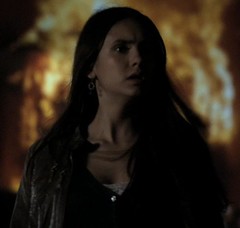
Kendra: Elena is clearly supposed to be the Scarlett O’Hara of the Civil War-obsessed Mystic Falls. They’re positioned next to each other in the season two finale: two dark haired, strong, southern women of different periods. As the season two finale progresses into chaos, so does Scarlett’s world on the screen in the town center. At one point Elena is literally shown as Scarlett, with the crumbling Mystic Falls taking the place of Scarlett’s burning Atlanta.
The writers had to know what they were doing. I understand that they were trying to highlight the idea of Elena being a strong female character, but was that really the message conveyed through Scarlett? A woman who (forgetting her numerous other flaws), is in the end left crying over a man on a staircase? It seems to go against the character Elena’s been built to be so far, and drags her back into Bella territory.
Jordan: The Gone with the Wind picnic viewing party in the season 2 finale left me deeply conflicted. As usual, there was a lot going on: Elena was fresh off of her resurrection, Damon was dying, his brother Stefan was bargaining for Damon’s life, Katherine was prowling about causing mischief, and there was a murderous ancient vampire/werewolf hybrid on the loose. Also, I know many black people like Gone with the Wind. It’s romantic, dramatic and an epic in every sense of the word. Clark Gable looks dashing as Rhett Butler and Vivien Leigh is a breathtaking Scarlett. Hattie McDaniel’s Mammy even earned her an Academy Award, making her the first African American woman to get one (another conversation for another day, especially with all attention The Help is getting this awards season.) I will also confess to having some baggage with the film that probably stems from first being exposed to it in a fourth grade social studies class when my teacher tried to pass it off as a “supplement” to our chapter on the Civil War (my mother flipped out).
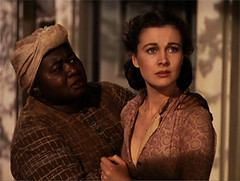
That said, even the staunchest GWTW fan has to admit that its portrayal of African Americans and African American women is flawed to say the least. Mammy and Prissy are one dimensional and stereotypical. They exist only to be Scarlett’s support system and comic relief. Rather than an oppressive, brutal institution where one set of people owned another, slavery comes across as a mutually beneficial, codependent relationship infused with friendship and loyalty and lacking any trace of violence and negativity.
Sure, the people of Mystical Falls might want to gloss over all of that and get caught up in the fabulous costumes, but Bonnie should know better. I can’t buy that she had not a moment of discomfort seeing women who look like her ancestors lampooning themselves on the screen. Even in this crazy town, she’s a teen and she wants to fit in, but for the souls of her dead ancestors, I needed her to say something. Not a whole rant - just a comment and side eye.
Kendra: And that’s what, once again, proves that there’s no one with our eye writing this show. You’re right- it didn’t need to be much. We didn’t need a speech, or a neck roll, or anything else obvious or elaborate. If Bonnie had just raised an eyebrow as she sat down at that picnic and said, “really though?” that would have been enough for me. It would have showed that yes, she’s grown up here, and she’s used to their foolishness, but she knows what’s up and she has a voice. Color blind casting is wonderful, but if you’re going to turn a character who was a white Irish-American Druid in the books into an African-American descendant of slaves in the American South, don’t half-ass it.
White Settlers, Native Werewolves, and one Black Witch: Is Anyone Parenting Bonnie Bennett? And Other Pertinent Questions
Jordan: I find it interesting that all of the main characters are given some backstory on their parents, home life and support system. While Bonnie is connected to her witch ancestors, after her grandmother’s passing there has been little to no talk of Bonnie’s home life. We never see a sibling, mother or father. Where she lives and who is looking after her seems to be a non issue. While other characters are given plenty to rely on, Bonnie is given no one and her strength is taken for granted. She asks for help when she needs it but leans on no shoulders and looks after herself. Why is it assumed that in a cast of characters including ancient and immortal beings, the lone black character can go it alone? Another insidious example of the strong black woman archetype playing out or a plot point they have been a little lazy about?
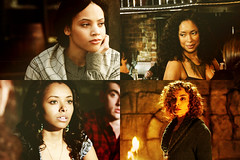
One of the most fascinating things about the series is that just about every black character who emerges from the background is a witch or warlock. In flashbacks showing us the ancestors of the current vampires in the TVD-verse, Ayanna, a witch of African descent warns them not to cast the spell that turns them into vampires but even before doing so, she appears to be helping them while they’re human, for reasons unknown. Likewise, one of the series’ key plot points - where there are vampires, there are witches - is never explained. Why are the witches, like Emily and Bonnie, placed in this position? They’re described as “servants of nature,” but they aid and work for creatures that are seen as abominations, with no explanation as to what is in it for them. Why are they situated as servants, and who exactly are they serving?
Kendra: You mentioned Mammy and Prissy from GWTW before, and I would argue that Bonnie, while not a slave, is essentially fulfilling that role as a support system. Bonnie is the one that every white character, even Stefan, runs to when they need help. This isn’t unique to her, since, as you’ve said, every vampire who appears on the show seems to have their very own Black witch or warlock in their back pockets, but very rarely do we find out anything else out about these characters. Bonnie’s father’s family is usually mentioned towards the beginning of the new season (she apparently spends her summers with them) but we’ve never met them, or her mother. Among the younger characters, Elena and Caroline both found parental figures, as did minor characters like Jeremy Gilbert and Tyler Lockwood still has his mother. Yet Bonnie gets nothing, aside from my dreams where Stacy Dash and Shemar Moore are cast as her parents.
Aside from a father and son unit we saw last season, these witches and warlocks often have no families, no support, and no motivation aside from serving the vampires they’re called to. All the vampires have allies. Bonnie, on the other hand, consistently acts as an ally while having none of her own. Regardless of race, I have to imagine that this would be hard on any teenager, and it’s a strange choice to not address the toll it takes on her.

I do think that the show has tried to explain this relationship off with the introduction of one of the original vampires, Klaus and his family into the new world and his mother’s friendship with Ayanna (who, by the way, seemed to be a very unfortunate knock-off of Pirates of the Caribbean‘s Tia Dalma). Ideally, the show would give us further explanation rooted in the fact that the witch was there when the first vampires were created. Granted, now that they’ve introduced the Fell doctor (rumored to be a witch, which begs another question: where do White witches come from in this universe?) I worry that they’ll completely ignore giving us an explanation now that they have shiny new white toys to play with. But for it to not become just another analogy about Blacks serving whites in the South, they really do need to fill in the holes in the show’s mythology.
My last point of interest involving the mid-season flashback was the implication that Tyler’s family comes from a long line of werewolves that were there before Klaus’ family showed up, as hinted by the cave drawings below Tyler’s family’s property. The show is obviously not committed to staying within a proper historical context, but does that mean that the Lockwoods are of Native descent? Are we talking skin-walkers instead of werewolves (forgetting the fact that Virginia would be the wrong area for the prevalence of that belief; I assume they just wouldn’t care)? And if we are going to learn anything about the Lockwood family history, is the writing team’s handling of it going to make me want to shoot my television?
Jordan: Yeah, the jury is still out on that one. I am not holding my breath for a thorough exploration of Native American skin-walker mythology. That episode is probably as likely as one explaining why most of TVD’s African American witches have distinctly light coloring. The writers might feel that takes too much time away from their picturesque plantation flashbacks. Snark aside, I was pleased to see that we’re finally supposed to see Bonnie’s mother soon. I am looking forward to meeting that witch - it’s a start, right?
Read more at the source.
Disclaimer: Obviously, I did not write or produce any of the content in this article, far better minds than mine did.
Table For Two: Kendra And Jordan Break Down The Vampire Diaries

By Guest Contributors Kendra James and Jordan St. John
Never seen The Vampire Diaries? Here’s a synopsis (with spoilers). There’s Elena (Nina Dobrev) the “average” popular orphan girl in Mystic Falls, VA. Caroline ( Candice Accola) her blond haired, blue eyed cheerleading frenemy and Bonnie (Kat Graham) her requisite black best friend and side kick. Elena also happens to be the spitting image of a vampire, Katherine, who loved Damon and Stefan Salvatore (brothers played by Ian Somerhalder and Paul Wesley) in the same town during the Civil War. Come 2009 the brothers return to Mystic Falls, only to both fall in love with Elena - a plot that makes just as much sense now as it did when TVD actually debuted as a book series in the early 1990s. But hey, let’s go with it.
Elena fell in love with Stefan during the show’s first season, but now things are heating up between her and Damon. It’s a crazy ride of a show but one of the most fascinating things is its strange dance with race. Set in the current south but with self-professed ties to the Civil War era and more recently precolonial America, as Dr. Sayantani DasGupta wrote for Racialicious last year, the show sometimes doesn’t know what to do with pesky issues like racism and slavery. As the show’s third season resumes this week, let’s look back at the racial implications and issues of the residents of Mystic Falls since the Season 2 finale.
Why We Love It
Kendra: In a media world saturated with vampires, werewolves, witches, and other secret societies, the show, now a mainstay on The CW network, has gone on to easily become my favorite hub of angsty supernatural teenage adventures. The cheesy premise disguises a surprisingly smart show that, once it found its’ stride during the first season, keeps me hooked with its nearly weekly cliffhangers and lead female characters who usually go out of their ways to be the anti-Bella Swan.
Jordan: I second that. TVD moves faster than any other show on television. Some subplots most series would spend half a season developing, unfold in the course of one episode (such as last season’s finale, where Elena’s Aunt/Guardian, father and brother all died in about a 15-minute span). And in a teen pop-culture landscape that is sometimes obsessed with female frailty and chastity, Elena isn’t even asked to apologize for simultaneously dating two brothers, and neither is Katherine. Yes, the women sometimes require saving but with a powerful female witch and vampire in the mix, they do the saving as well.
Why It’s Still A CW Show
Kendra: Like we said earlier, the show anchors itself in the American past and deals with it in some curious - and problematic - ways, often featuring flashbacks to the Civil War and present-day town events influenced by it. I wish I could understand why everyone’s decided vampires are all Southern these days, but that’s where we are, and TVD will always, to me, be a younger and better version of True Blood. But it’s not perfect. The show’s writers could have easily acknowledged the racial and social issues that come with placing yourself within the context of war and tackled the issues head on, instead of dancing around as True Blood tends to do.

Jordan: Alas, TVD goes a couple steps forward - adding Bonnie as a main character (and a whole line of black witches) and including a Civil War era Asian vampire, Pearl, and then stumbles back by shying away from addressing the legacy of slavery in the American south and falling into stereotypes. I usually applaud color blind casting in fantasy or supernatural (the only reason I watch Merlin is because they made the future Queen Guinevere multiracial. If you are in a fictional place where dragon’s talk, I applaud it when producers do not carryover our preconceptions of race) but that only works when the setting is another world - not the current American south.
The Mystic Falls Civil War Fetish
Kendra: Moving the Salvatore brothers’ history into the Civil War had to be an extremely conscious decision on the part of series creator and producer Kevin Williamson and his team, because none of that is actually a part of author L.J. Smith’s original books, in which the Salvatores were both supposedly turned during the Italian Renaissance.

Now, I can understand why he did it: True Blood was already popular by the time TVD premiered, and the public showed it loved them some southern vampires. And a war on American soil is something the main TVD audience (Americans in the 18-35 demographic) is going to know more about and possibly find more relatable than something going on in Italy. But it never fails to amaze me how a well documented period in American history can be glossed over so thoroughly, and I always wonder why it’s a period chosen so frequently as a media plot device when no writing staff is actually brave enough to use it for what it really was.
A friend of mine jokingly said to me that the show must take place in some sort of alternate America where the War somehow didn’t end as badly, no one in the south is resentful about it, and it wasn’t a complete disadvantage to be a person of color in the south during and before the 1860s. Mystic Falls is presented as an idyllic town where attractive men dress in Rebel Greys and the women dress in Southern Belle gowns for various town occasions, where Black servants during the war were referred to as ‘handmaidens’, and where a fully multicultural town (including Asians!) was perfectly normal for Virginia in 1865.
So why obsess over the conflict if you’re not going to acknowledge it for what it was?
Jordan: TVD seems to be pulling a Bagger Vance - and if you ever want to see a movie with a black main character in the south completely gloss over race, it is a truly striking example; I literally wrote a paper on it. In most of the flashbacks, we have Bonnie’s ancestor, Emily Bennett serving Katherine: She provides her with a ring to walk around in the daylight and also provides daywalking ring for the newly turned Salvatore brothers. While I understand the need for Emily to assist with a number of plot points, I am disappointed that they never take the time to look at Emily as a dynamic character. What is her backstory? Why is a black witch who has the power to control humans and vampires, staying with an evil, murderous vampire in the Civil War era south? Why is she helping her? Emily does always put her own family first whenever her or any of her descendants are threatened, but the lack of time spent looking into her motivations is a glaring omission.
All I need is a nod to slavery - an acknowledgement that there is another facet to the plantation era American south that was not about bonnets, balls and “servants” who all happened to share a skin tone. True Blood has its own faults, but the scene when Tara asked if Bill ever had slaves will always have a place in my heart.

TVD has rare instances of this kind of honesty that I appreciate. I love that earlier in the series, when a southern matriarch is asked by her son about a dungeon on their old plantation property (which actually was used to chain up werewolves) she assumed it had been used to hold slaves and told him in terse terms that it wasn’t something the family liked to discuss before quickly moving on to other things. There are ways to incorporate the darker parts of southern history into the plot but they take a little effort and creativity. All too often, the show shirks from the challenge and opts to gloss over the realities of the Civil Was era. For example, the Salvatores were people of stature in a southern, plantation town, meaning they would have certainly owned slaves. I would love for at least one person to acknowledge that - preferably Bonnie.
Kendra: While watching the mid-season premiere, I was asked, “Why is Emily Bennett still holding that grudge against the Salvatores? It’s been over a century!” a question that pinpoints the problem with dodging the town’s history of slavery. To me, even peeling away the vampiric elements of the story, I have absolutely no problem imagining why Emily, a powerful Black woman would continue to hold a grudge against two rich (potentially slave holding), southern white men from she’d known in 1865. I wish there was someone in that writer’s room willing to take a non-white perspective into account. Not only do I find it problematic that my own view isn’t acknowledged, it’s concerning to me that this idyllic view of the Confederate South is presented without question or discourse to a large swath of young, white CW-watching America.
Romanticizing and whitewashing the African-American experience isn’t a new occurrence (see: Gone With The Wind or Douglas Sirk’s remake of Imitation of Life, to name a few), and it’s troubling to see the trend surface again in 2012. To be fair, this show isn’t the only pop culture phenom guilty of peddling a “safer” version of Southern America and Confederate history to the American youth. It’s simply the most recent. Acts like Taylor Swift and Lady Antebellum, and programs like its’ CW compatriot Hart of Dixie all conjure up images of the “Safe South” in their descriptions (lyrically) and depictions (visually) of the region.
Now, I’m not recommending that today’s youth get their history lessons from the CW and Taylor Swift, but the fact remains that even I, as a young Black kid, was drawn into the romanticism of the Old South. A visceral book description (visceral for an 8-10 year old, at least) of my American Girl Doll, Addy, being forced to eat grubs off a tobacco leaf by her overseer fixed that up right quick, and I suppose I worry that others -white and Black- aren’t going to receive the same historical wake up call if Lady Antebellum, Taylor Swift, and TVD are the only influences to shape their impressions of the South. Paying attention in history class plays a part, yes, but a visual and a pretty face go a long way.
Elena Gilbert as Scarlett O’Hara

Kendra: Elena is clearly supposed to be the Scarlett O’Hara of the Civil War-obsessed Mystic Falls. They’re positioned next to each other in the season two finale: two dark haired, strong, southern women of different periods. As the season two finale progresses into chaos, so does Scarlett’s world on the screen in the town center. At one point Elena is literally shown as Scarlett, with the crumbling Mystic Falls taking the place of Scarlett’s burning Atlanta.
The writers had to know what they were doing. I understand that they were trying to highlight the idea of Elena being a strong female character, but was that really the message conveyed through Scarlett? A woman who (forgetting her numerous other flaws), is in the end left crying over a man on a staircase? It seems to go against the character Elena’s been built to be so far, and drags her back into Bella territory.
Jordan: The Gone with the Wind picnic viewing party in the season 2 finale left me deeply conflicted. As usual, there was a lot going on: Elena was fresh off of her resurrection, Damon was dying, his brother Stefan was bargaining for Damon’s life, Katherine was prowling about causing mischief, and there was a murderous ancient vampire/werewolf hybrid on the loose. Also, I know many black people like Gone with the Wind. It’s romantic, dramatic and an epic in every sense of the word. Clark Gable looks dashing as Rhett Butler and Vivien Leigh is a breathtaking Scarlett. Hattie McDaniel’s Mammy even earned her an Academy Award, making her the first African American woman to get one (another conversation for another day, especially with all attention The Help is getting this awards season.) I will also confess to having some baggage with the film that probably stems from first being exposed to it in a fourth grade social studies class when my teacher tried to pass it off as a “supplement” to our chapter on the Civil War (my mother flipped out).

That said, even the staunchest GWTW fan has to admit that its portrayal of African Americans and African American women is flawed to say the least. Mammy and Prissy are one dimensional and stereotypical. They exist only to be Scarlett’s support system and comic relief. Rather than an oppressive, brutal institution where one set of people owned another, slavery comes across as a mutually beneficial, codependent relationship infused with friendship and loyalty and lacking any trace of violence and negativity.
Sure, the people of Mystical Falls might want to gloss over all of that and get caught up in the fabulous costumes, but Bonnie should know better. I can’t buy that she had not a moment of discomfort seeing women who look like her ancestors lampooning themselves on the screen. Even in this crazy town, she’s a teen and she wants to fit in, but for the souls of her dead ancestors, I needed her to say something. Not a whole rant - just a comment and side eye.
Kendra: And that’s what, once again, proves that there’s no one with our eye writing this show. You’re right- it didn’t need to be much. We didn’t need a speech, or a neck roll, or anything else obvious or elaborate. If Bonnie had just raised an eyebrow as she sat down at that picnic and said, “really though?” that would have been enough for me. It would have showed that yes, she’s grown up here, and she’s used to their foolishness, but she knows what’s up and she has a voice. Color blind casting is wonderful, but if you’re going to turn a character who was a white Irish-American Druid in the books into an African-American descendant of slaves in the American South, don’t half-ass it.
White Settlers, Native Werewolves, and one Black Witch: Is Anyone Parenting Bonnie Bennett? And Other Pertinent Questions
Jordan: I find it interesting that all of the main characters are given some backstory on their parents, home life and support system. While Bonnie is connected to her witch ancestors, after her grandmother’s passing there has been little to no talk of Bonnie’s home life. We never see a sibling, mother or father. Where she lives and who is looking after her seems to be a non issue. While other characters are given plenty to rely on, Bonnie is given no one and her strength is taken for granted. She asks for help when she needs it but leans on no shoulders and looks after herself. Why is it assumed that in a cast of characters including ancient and immortal beings, the lone black character can go it alone? Another insidious example of the strong black woman archetype playing out or a plot point they have been a little lazy about?

One of the most fascinating things about the series is that just about every black character who emerges from the background is a witch or warlock. In flashbacks showing us the ancestors of the current vampires in the TVD-verse, Ayanna, a witch of African descent warns them not to cast the spell that turns them into vampires but even before doing so, she appears to be helping them while they’re human, for reasons unknown. Likewise, one of the series’ key plot points - where there are vampires, there are witches - is never explained. Why are the witches, like Emily and Bonnie, placed in this position? They’re described as “servants of nature,” but they aid and work for creatures that are seen as abominations, with no explanation as to what is in it for them. Why are they situated as servants, and who exactly are they serving?
Kendra: You mentioned Mammy and Prissy from GWTW before, and I would argue that Bonnie, while not a slave, is essentially fulfilling that role as a support system. Bonnie is the one that every white character, even Stefan, runs to when they need help. This isn’t unique to her, since, as you’ve said, every vampire who appears on the show seems to have their very own Black witch or warlock in their back pockets, but very rarely do we find out anything else out about these characters. Bonnie’s father’s family is usually mentioned towards the beginning of the new season (she apparently spends her summers with them) but we’ve never met them, or her mother. Among the younger characters, Elena and Caroline both found parental figures, as did minor characters like Jeremy Gilbert and Tyler Lockwood still has his mother. Yet Bonnie gets nothing, aside from my dreams where Stacy Dash and Shemar Moore are cast as her parents.
Aside from a father and son unit we saw last season, these witches and warlocks often have no families, no support, and no motivation aside from serving the vampires they’re called to. All the vampires have allies. Bonnie, on the other hand, consistently acts as an ally while having none of her own. Regardless of race, I have to imagine that this would be hard on any teenager, and it’s a strange choice to not address the toll it takes on her.

I do think that the show has tried to explain this relationship off with the introduction of one of the original vampires, Klaus and his family into the new world and his mother’s friendship with Ayanna (who, by the way, seemed to be a very unfortunate knock-off of Pirates of the Caribbean‘s Tia Dalma). Ideally, the show would give us further explanation rooted in the fact that the witch was there when the first vampires were created. Granted, now that they’ve introduced the Fell doctor (rumored to be a witch, which begs another question: where do White witches come from in this universe?) I worry that they’ll completely ignore giving us an explanation now that they have shiny new white toys to play with. But for it to not become just another analogy about Blacks serving whites in the South, they really do need to fill in the holes in the show’s mythology.
My last point of interest involving the mid-season flashback was the implication that Tyler’s family comes from a long line of werewolves that were there before Klaus’ family showed up, as hinted by the cave drawings below Tyler’s family’s property. The show is obviously not committed to staying within a proper historical context, but does that mean that the Lockwoods are of Native descent? Are we talking skin-walkers instead of werewolves (forgetting the fact that Virginia would be the wrong area for the prevalence of that belief; I assume they just wouldn’t care)? And if we are going to learn anything about the Lockwood family history, is the writing team’s handling of it going to make me want to shoot my television?
Jordan: Yeah, the jury is still out on that one. I am not holding my breath for a thorough exploration of Native American skin-walker mythology. That episode is probably as likely as one explaining why most of TVD’s African American witches have distinctly light coloring. The writers might feel that takes too much time away from their picturesque plantation flashbacks. Snark aside, I was pleased to see that we’re finally supposed to see Bonnie’s mother soon. I am looking forward to meeting that witch - it’s a start, right?
Read more at the source.
Disclaimer: Obviously, I did not write or produce any of the content in this article, far better minds than mine did.